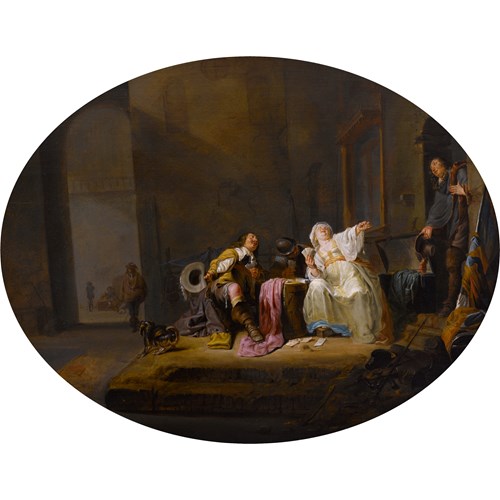Marketplace
Horseman on the Russian Steppe
Christian Adolf Schreyer
Horseman on the Russian Steppe
Date 1869
Epoque 1850-1900, 19th century
Origine Germany
Medium Oil on canvas
Dimension 55 x 73 cm (21⁵/₈ x 28³/₄ inches)
A solitary Cossack traveller makes his way through the empty wilderness of the Russian Steppe, with only his two horses for company. Under a darkening sky, the party appear consumed by weariness, especially the riderless horse, which has its head bowed as it trudges through the uneven terrain. The horseman looks across at the empty saddle, drawing attention to it and raising the question of what has happened to the second rider. Surrounding this foreground group is the vast expanse of the Russian Steppe, which stretches away into the distance and blends into the night sky on the dark horizon. The landscape appears slightly wild and rocky, with tufts of grass penetrating the dusting of snow. The sheer vastness of this landscape, and its lack of cultivation, further adds to the sense of lonely isolation which is suggested by the riderless horse.
Christian Adolf Schreyer was one of the most notable of the nineteenth-century Orientalist painters, his equine scenes winning him acclaim throughout Europe. The horsemen in his work can broadly be categorised as either Arabs or, as in the present work, Cossacks. As can be seen in both Horseman on the Russian Steppe and Cossacks Scouting in a Winter Landscape (Private Collection), Schreyer’s Cossacks are often depicted struggling through a slightly wild and inhospitable landscape. In both works, the landscape takes on a daunting scale, and the figures seem to toil through it. To a contemporary European viewer, these scenes would feel alien, intimidating but fascinating.
It is also instructive to compare Schreyer’s portrayal of Cossack life in the present work, to his depictions of Arabs, in paintings such as Arab Horseman, (Private Collection). Whereas the Cossack’s life is portrayed as one of hardship, as he and the horses plod wearily through the cold night, the Arab appears proud and exotic, as he surveys the surrounding landscape. The Cossack is wrapped in thick, drab clothing, in contrast to the billowing white cape and colourful adornments, which the Arab wears. Even the horses seem to have very different characters, the elegance of the Arab’s steed contrasting with the squat, slightly downtrodden appearance of those in the present work. However, in both works Schreyer’s skill as an equine painter is clear, as is his interest with his unfamiliar and fascinating subjects.
Schreyer was one of the most successful Oriental painters of his generation, winning numerous international awards and honours. During his artistic training, he studied equine anatomy, and his work is notable for the confidence with which he depicts horses. He first travelled to Russia and the Caucasus as an artist-reporter, assigned to cover the Crimean War, but he continued to explore the region throughout his life, immersing himself with local customs and traditions. Early in his career he tended to depict the frenzy of battle, but as he matured his figures become more solitary and studied, as can be seen in the present piece. His work stands apart from the tightly painted and extremely detailed paintings of his German and Austro-Hungarian contemporaries, due to the bravura of his loose and expressive technique, something which is clearly evident in Horseman on the Russian Steppe.
Christian Adolf Schreyer was one of the most notable of the nineteenth-century Orientalist painters, his equine scenes winning him acclaim throughout Europe. The horsemen in his work can broadly be categorised as either Arabs or, as in the present work, Cossacks. As can be seen in both Horseman on the Russian Steppe and Cossacks Scouting in a Winter Landscape (Private Collection), Schreyer’s Cossacks are often depicted struggling through a slightly wild and inhospitable landscape. In both works, the landscape takes on a daunting scale, and the figures seem to toil through it. To a contemporary European viewer, these scenes would feel alien, intimidating but fascinating.
It is also instructive to compare Schreyer’s portrayal of Cossack life in the present work, to his depictions of Arabs, in paintings such as Arab Horseman, (Private Collection). Whereas the Cossack’s life is portrayed as one of hardship, as he and the horses plod wearily through the cold night, the Arab appears proud and exotic, as he surveys the surrounding landscape. The Cossack is wrapped in thick, drab clothing, in contrast to the billowing white cape and colourful adornments, which the Arab wears. Even the horses seem to have very different characters, the elegance of the Arab’s steed contrasting with the squat, slightly downtrodden appearance of those in the present work. However, in both works Schreyer’s skill as an equine painter is clear, as is his interest with his unfamiliar and fascinating subjects.
Schreyer was one of the most successful Oriental painters of his generation, winning numerous international awards and honours. During his artistic training, he studied equine anatomy, and his work is notable for the confidence with which he depicts horses. He first travelled to Russia and the Caucasus as an artist-reporter, assigned to cover the Crimean War, but he continued to explore the region throughout his life, immersing himself with local customs and traditions. Early in his career he tended to depict the frenzy of battle, but as he matured his figures become more solitary and studied, as can be seen in the present piece. His work stands apart from the tightly painted and extremely detailed paintings of his German and Austro-Hungarian contemporaries, due to the bravura of his loose and expressive technique, something which is clearly evident in Horseman on the Russian Steppe.
Date: 1869
Epoque: 1850-1900, 19th century
Origine: Germany
Medium: Oil on canvas
Signature: Signed and dated ‘Alf. Schreyer/1869’ (lower left).
Dimension: 55 x 73 cm (21⁵/₈ x 28³/₄ inches)
Plus d'œuvres d'art de la Galerie









